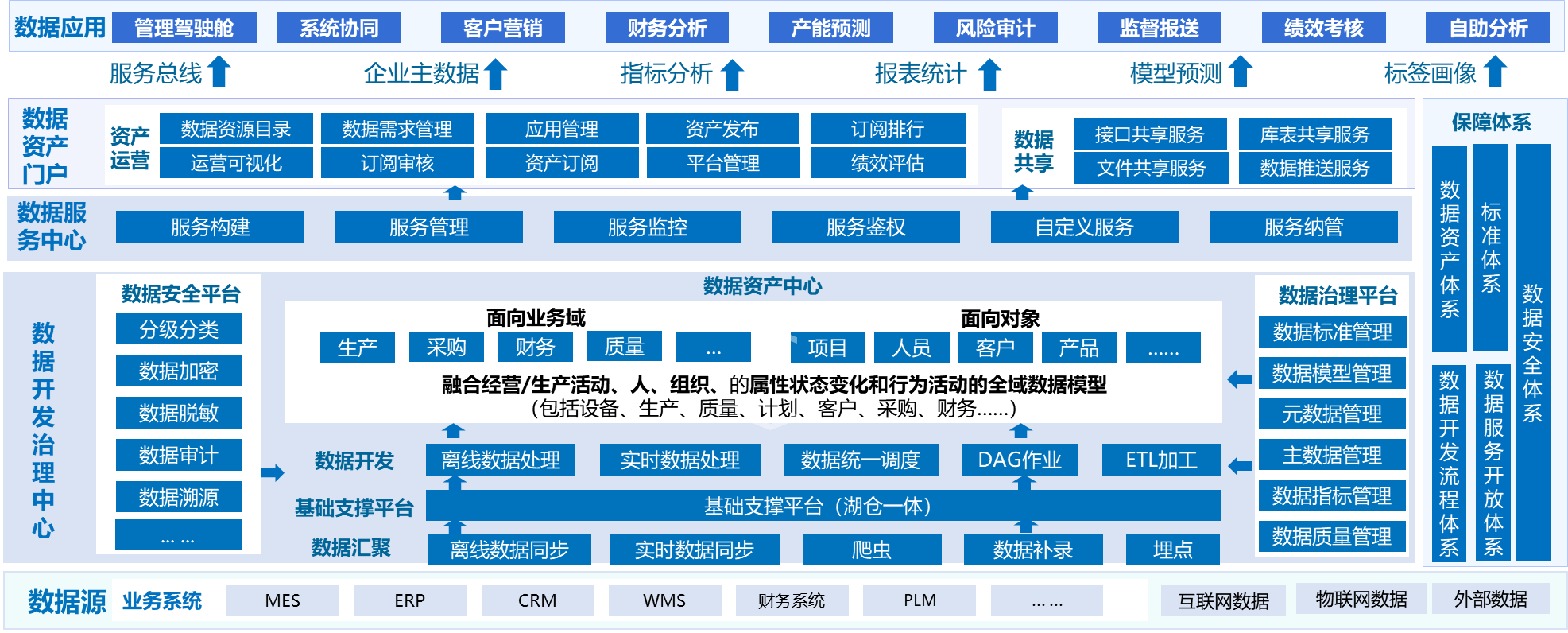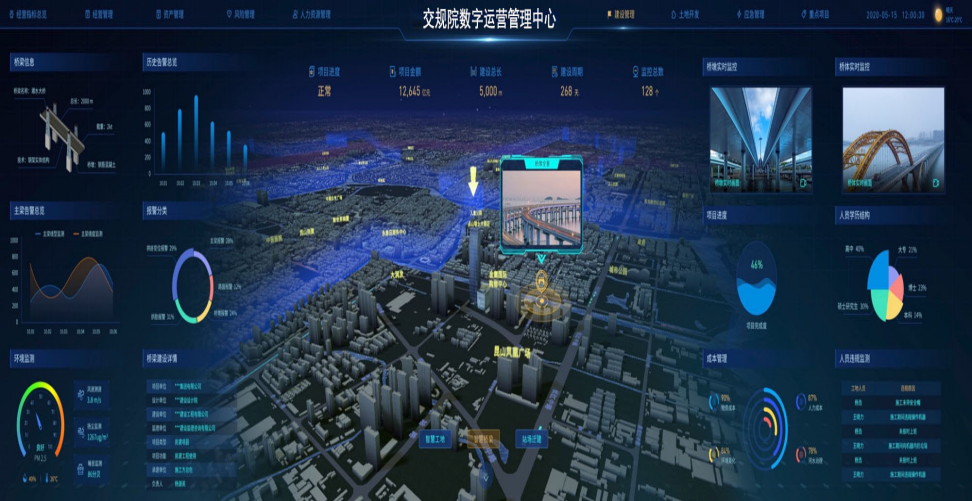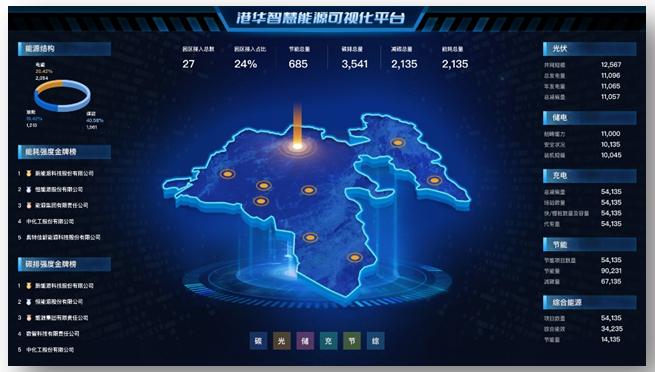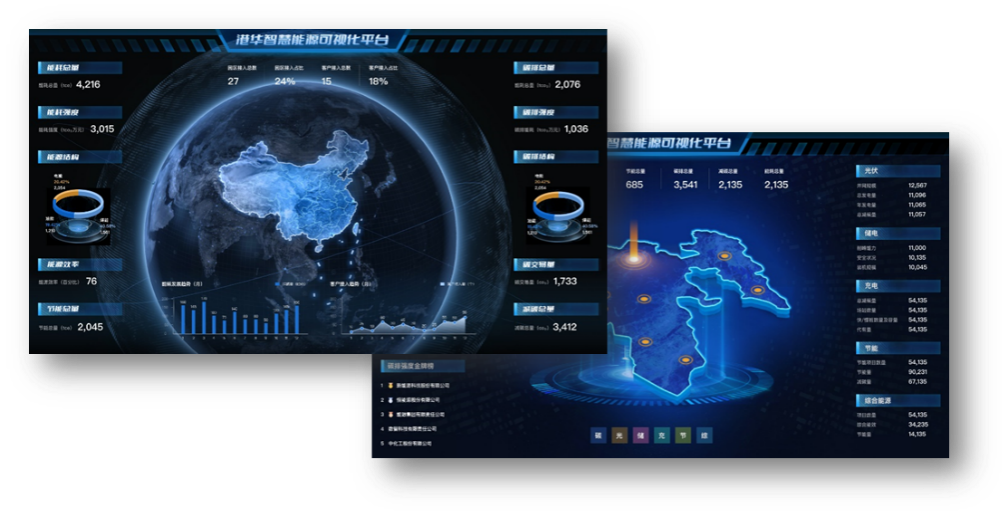

Digital government, smart cities

Enterprises have accumulated a large amount of data resources in the course of production, operation and management. In view of the massive data resources, complex business and multi-disciplinary application scenarios, the digital transformation "One Foundation" solution has constructed a one-stop data asset model with the following features: "Setting specifications, constructing platforms, building assets, and setting up applications", including four core elements. The one-stop data asset model includes four core elements: First, based on the DCMM "Data Management Capability Maturity Assessment Model", combining the business and data management status quo, constructing the data management organization structure, management system and process, and forming a standardized data management system; second, establishing an enterprise-level data asset management platform to support data storage, development, service and application, and carrying out "acquisition, storage, calculation, calculation and application" of data; second, establishing an enterprise-level data asset management platform to support data storage, development, service and application. "The enterprise-level data asset management platform is established to support data storage, development, service and application, so as to carry out the full life cycle management of data acquisition, storage, calculation, management and application; third, it covers the complete process of data acquisition, processing and cleaning, and application service, and aggregates the data of various business fields, so as to construct the enterprise-level data asset system; fourth, it constructs the enterprise-level digital brain, builds the full-scenario analysis and application system of enterprise operation and management, and enhances the role of data empowerment, and plays the role of data elements. Enabling role, to play the multiplier effect of data elements.

1. Adhere to the national standards and establish a comprehensive data management system: Adhere to the national standard of DCMM "Data Management Capability Maturity Assessment Model" to establish a robust data management system tailored for the enterprise. This system clearly define responsibilities and division of labor for data governance, standardize data management practices and operations, optimize data management processes and mechanisms, and enhance data quality and security.
2、One-stop asset operation management for establishing a data asset system:Relying on the data asset platform, it realizes one-stop efficient management of enterprise data access, development, governance, service and operation, carries out in-depth fusion and governance of domain-wide data, and builds a comprehensive enterprise data asset system.
3、Unlocking data value and empowering "research, production, supply, sales, and service” in all scenarios: The platform optimizes data flow across the enterprise's business processes, offering data services, master data management, metrics analysis, and labeling capabilities throughout research, production, and sales stages. This holistic approach greatly improves the enterprise's operational efficiency and management effectiveness.
4、Fully compatible with IT application innovation, supporting mainstream platforms:It has realized the adaptation of domestic servers, operating systems, databases, middleware and other Xinchuang, compatible with mainstream big data platforms such as Tencent, Huawei, CDH, etc., and has landed and delivered in a number of large-scale projects.


Digital Transformation "One Foundation" Architecture Map

Through the construction of the enterprise data asset management platform, the data flow and business flow within the enterprise can be comprehensively opened up to further promote the sharing of data resources across departments, businesses and networks, give full play to the value of the circulation of data within the enterprise, enhance the efficiency of business collaboration among various departments, build an operation and management mode of data-driven business and process innovation, improve the response speed of the business side to customer needs, and continuously optimize the quality of the enterprise's products and services, thus enhancing the enterprise's comprehensive competitiveness in the market. Optimize the product and service quality of the enterprise, so as to enhance the comprehensive competitiveness of the enterprise in the market.

Scenario 1: Cockpit Management
The enterprise data asset management platform, at the heart of business empowerment, offers top management an intuitive cockpit by aggregating and governing data across various business units. The cockpit displays important indicators such as sales trends, inventory levels, production efficiency, financial health, etc. It also supports data drilling and in-depth analysis of the reasons behind the data, so that corporate management can grasp the status of corporate operations at a glance, and through the Management Cockpit, quickly identify potential business opportunities and risks, and make timely strategic adjustments, to ensure the sustained and steady development of the enterprise.
Scenario 2: Customer Marketing
In the customer marketing scenario, the data asset management platform enables the development of a 360-degree customer portrait application by integrating multi-dimensional data, including customer behavior, preferences, and purchasing history. This provides the enterprise with deep customer insights, supporting the planning and execution of precise marketing activities. Enterprises can provide customized product recommendations, promotions and service experiences based on customer profiles, thus enhancing customer stickiness and increasing market share. At the same time, the platform is based on the aggregated marketing campaign effect monitoring data, which effectively supports the adjustment of subsequent marketing strategies, ensures the efficient utilization of marketing resources, and helps enterprises to build long-term and stable customer relationships.
Scenario 3: Financial Analysis
In the financial analysis scenario, the data asset management platform integrates financial data from ERP, CRM, bank flows, and other systems, enabling complex financial statement generation and real-time financial analysis. Utilizing big data analytics, the platform is able to deeply analyze the composition of enterprise costs, including direct costs, indirect costs, fixed costs, variable costs, etc., revealing cost drivers and trends. Meanwhile, based on the platform's real-time data analysis capabilities, the finance team is able to instantly monitor key financial indicators, such as cash flow, asset-liability ratios, and revenue trends, to quickly identify potential financial risks or anomalies. In addition, the cost-benefit analysis model can help companies identify cost-saving opportunities, develop targeted cost-control strategies, and improve the overall operational efficiency of the company.
Scenario 4: Capacity Forecasting
In the capacity forecasting scenario, the data asset management platform provides enterprises with accurate capacity forecasts by integrating and analyzing multi-dimensional data such as historical production data, including historical production data, market demand trends, and supply chain conditions. On the one hand, the platform collects multi-source information from production site sensors, equipment status monitoring, order management system and external market data, etc. Through deep mining of past data on capacity utilization, equipment efficiency, failure rate, etc., the platform discovers hidden correlations and cyclical patterns, and lays a solid data foundation for capacity prediction. On the other hand, the platform supports the seamless docking of upstream and downstream data in the supply chain, and incorporates the supplier delivery cycle, logistics time, and customer order forecast into the capacity prediction model, which helps enterprises to more accurately predict the capacity demand, optimize the inventory management, reduce the wastage, and improve the overall responsiveness and flexibility of the supply chain.
Scenario 5: Risk Audit
The enterprise data asset management platform constructs analysis and early warning models by aggregating ledger data, financial data, and transaction data. By aligning these with the enterprise's risk management needs and utilizing a rule engine to set risk thresholds, the platform intelligently analyzes fundraising risk, investment risk, capital recovery risk, and liquidity risk. This empowers enterprise leadership with data services for risk foreknowledge, prediction, and prevention.
Scenario 6: Performance Appraisal
In the performance appraisal scenario, the platform seamlessly interfaces with various internal business systems (e.g., CRM, ERP, HRIS, etc.) as well as external data sources (e.g., market research, industry reports, etc.) to comprehensively gather multi-dimensional information on employees' work progress, project outcomes, sales performance, disciplinary assessments, teamwork, and more. Through the integration and cleaning of data, it supports the construction of a comprehensive performance portrait of each employee, providing a solid data foundation for comprehensive and objective assessment of performance, helping enterprises quantify the contribution of employees, stimulate team potential, and optimize the allocation of human resources.

China Merchants Group Data Asset Management Platform Project
Guangzhou Metro Suiteng OS 2.0 Project
Beijing State-owned Assets Supervision Data Middle Platform Project
Oni Electronic Data Platform Project
Hong Kong and China Intelligent Energy Eco-Platform Phase II Project
Xingnong Intelligent Science and Technology Data Middle Platform Project
Hubei Institute of Traffic Planning Digital Transformation Construction Project
Yangtze River Design Integrated Management Work Platform Project
Awards
Selected as one of the "High-quality Digital Transformation Products and Services" of China Information and Communication Technology Agency (ICTA) Panorama (2023)" by China
Academy of Information and Communications Technology (CAICT) Outstanding Award in "Data Governance Innovation" Track of the 1st China Big Data Competition at the China International Digital Economy Expo (CIDEE) 2022
Outstanding Software Product of 2018 by China Software Industry Association (CSIA)

